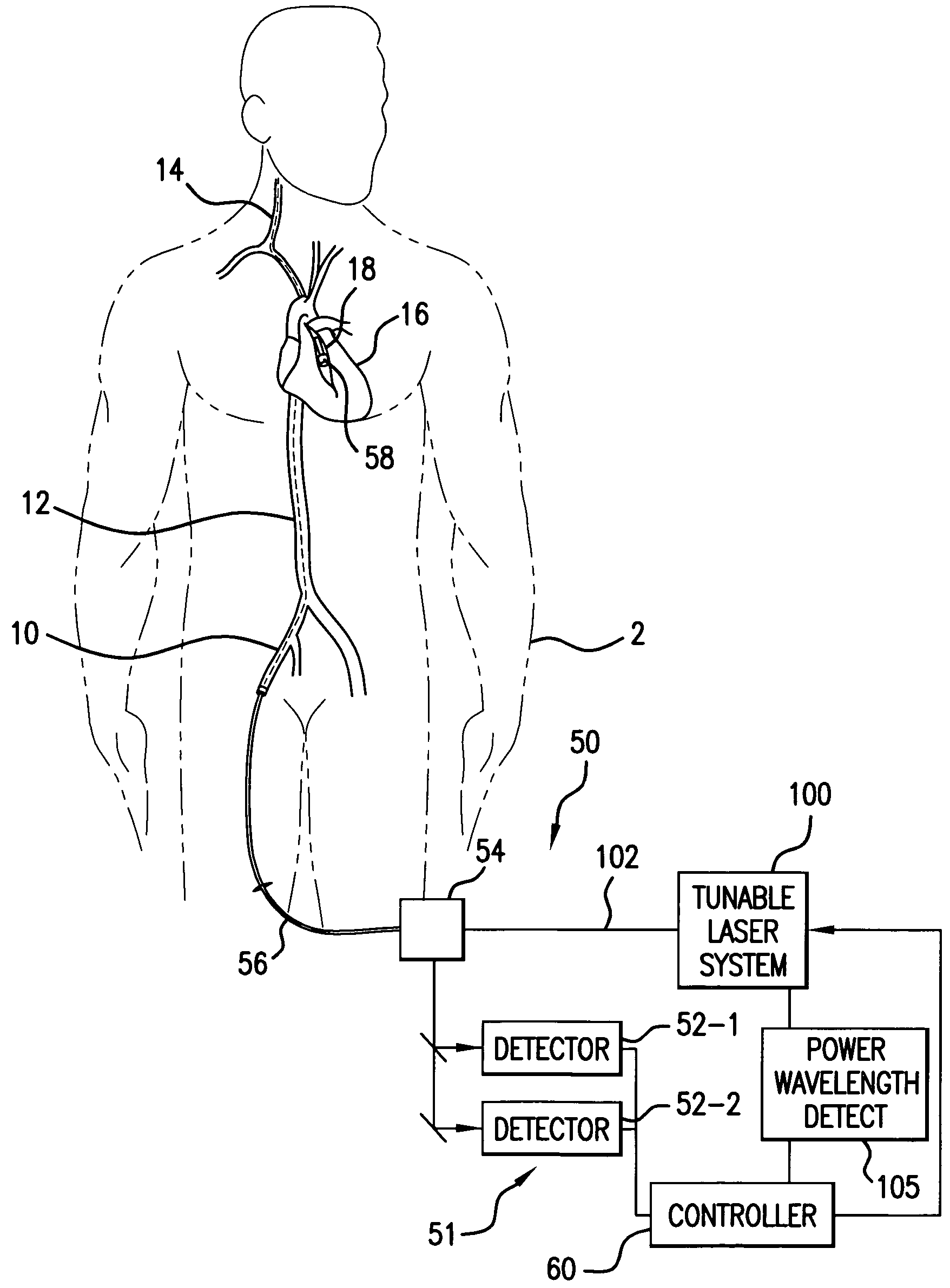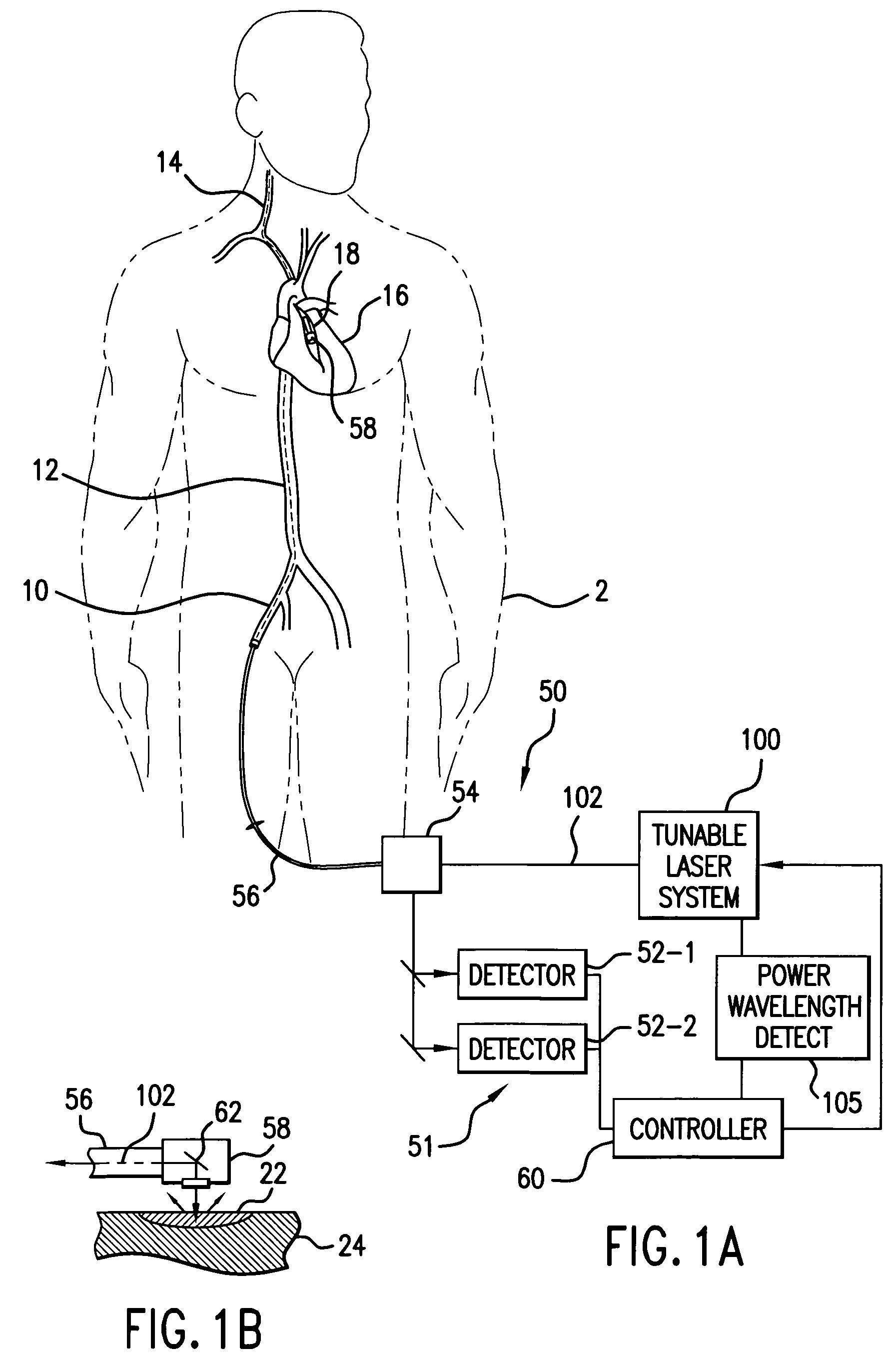Spectroscopic catheter system with widely tunable source and method of operation
a spectroscopic catheter and source technology, applied in the direction of catheters, instruments, diagnostics using spectroscopy, etc., can solve the problems of limited 0.1 to 100 nm gain bandwidth of optical amplifiers, few existing technologies can provide optical signals, etc., and achieve stable and controlled environment, low cost, and low cost
- Summary
- Abstract
- Description
- Claims
- Application Information
AI Technical Summary
Benefits of technology
Problems solved by technology
Method used
Image
Examples
first embodiment
[0066]During operation, the first embodiment is tuned by progressively controlling the tilt of the frequency selective tunable element 140. As its feedback passes through the gain bandwidth of the SOA chip of first module 110-1, the first module provides the optical gain in the laser cavity. Then, as the frequency selective tunable element rotates further, its feedback passes through the gain bandwidth of the second module 110-2, which then provides the gain to the cavity.
[0067]FIG. 7 shows a second specific embodiment of the tunable laser source 100, which uses polarization diversity to achieve a low loss combination of the outputs from the two modules. The fiber pigtails 114-1, 114-2 from the modules 110-1, 110-2 comprise polarization-maintaining (PM) fiber. This fiber maintains the polarization state of the typically highly polarized energy from the chips 117 of the modules 110-1, 110-2.
[0068]One of the pigtails 114-1, 114-2 has an axis that is rotated 90 degrees with respect to ...
fourth embodiment
[0070]FIG. 9 shows the optical laser source 100. In this example, a WDM combiner 152 is used to combine and split the optical signals on the pigtails 114-1, 114-2 from the modules 110-1, 110-2. WDM combiner 152 is typically a thin film dichroic filter. It uses the spectrally distributed outputs from the two modules 110-1, 110-2 to combine their respective optical signals. A splitter / output coupler 130 couples to the frequency selectable tunable element 140 via the free space collimator 142 and provides the tap for the output signal 102.
[0071]The fourth embodiment has spectral dead zone due to the transition in the WDM filter 152. This dead zone will typically consume about 0.5 nanometers of the tuning curve. Further, power can be doubled by polarization combining two modules for each wavelength band.
fifth embodiment
[0072]FIG. 10 illustrates the tunable laser system 100. In this example, a one-by-two switch 154 is used to select one of modules 110-1, 110-2, and provide its output to a splitter / output coupler 130. In this example, only one of the laser modules 110-1, 110-2, is providing the gain to the laser cavity at any moment during operation.
[0073]In other embodiments, where additional modules combined, this system can be scaled to wider bandwidths of operation by increasing the port count of the switch 154 to a one-by-n switch, where n equals the number of modules.
[0074]The fifth embodiment, however, provides a non-zero switching time of a few milliseconds due to the operation of the switch 154. This creates a limited spectral dead zone. On the other hand, power can be doubled by polarization combining the output from two modules at each switch port.
PUM
 Login to View More
Login to View More Abstract
Description
Claims
Application Information
 Login to View More
Login to View More - R&D
- Intellectual Property
- Life Sciences
- Materials
- Tech Scout
- Unparalleled Data Quality
- Higher Quality Content
- 60% Fewer Hallucinations
Browse by: Latest US Patents, China's latest patents, Technical Efficacy Thesaurus, Application Domain, Technology Topic, Popular Technical Reports.
© 2025 PatSnap. All rights reserved.Legal|Privacy policy|Modern Slavery Act Transparency Statement|Sitemap|About US| Contact US: help@patsnap.com



